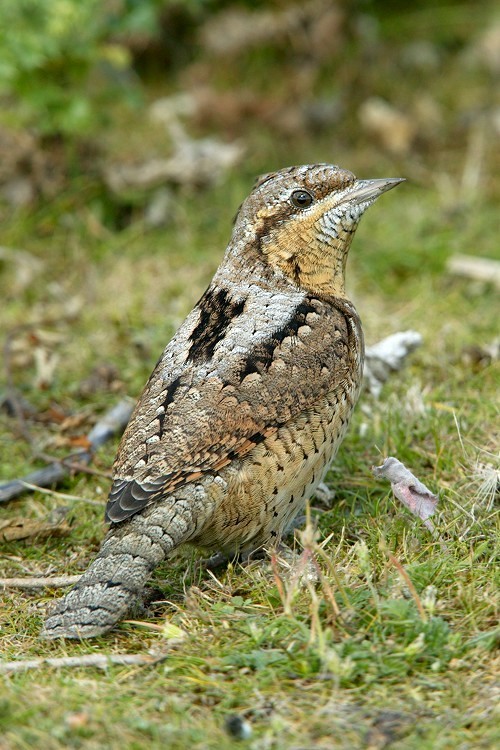m (→Distribution: Dictionary link) |
|||
| (45 intermediate revisions by 16 users not shown) | |||
| Line 1: | Line 1: | ||
| − | + | [[Image:120Wryneck E2D3291.jpg|thumb|550px|right|Photo © by {{user|Nigelblake|Nigel Blake}}<br />[[Norfolk]], [[UK]], September 2006]] | |
| − | [[Image: | + | ;[[:Category:Jynx|Jynx]] torquilla |
| − | |||
| − | |||
==Identification== | ==Identification== | ||
| − | + | Length 16-18 cm (6-7 in), weight 30-50 g. An unusual, distinctive woodpecker. | |
| − | + | * Mottled grey and brown above | |
| − | + | * Buffish-ochre breast dark vermiculated | |
| − | + | * Whitish belly dark vermiculated | |
| − | + | * Dark line through eye and down neck-side | |
| − | + | * Broad dark line along centre of crown and back | |
| + | * Short pointed bill | ||
| + | Sexes similar. | ||
| − | + | ====Similar species==== | |
| + | [[Rufous-necked Wryneck]] has rufous on throat and breast and has streaked (not barred) flanks. | ||
| − | + | In poor light or at a distance, and particularly in flight, can be mistaken for a [[Barred Warbler]] or a small [[:Category:Lanius|shrike]]. | |
| − | == | + | |
| − | < | + | ==Distribution== |
| − | + | Breeds widely across [[Europe]] from northern Iberia and western [[France]] east to the Urals, Caspian and north Caucasus and across temperate [[Asia]] to [[China]] and northern [[Japan]]. In the north, virtually absent from [[British Isles]], but breeds over most of [[Scandinavia]] except the higher mountains and the far north (locally north to 70°N), and across [[Russia]] south of 65°N. Breeds south to the northern coast of the Mediterranean from north-east Spain to northern Greece, in southern [[Portugal]], and on [[Mallorca]], [[Ibiza]], [[Corsica]], [[Sardinia]] and [[Sicily]]. Also breeds in the Atlas Mountains in northern [[Algeria]] and [[Tunisia]]. | |
| + | |||
| + | Mainly a summer visitor but in the far south of range may be partially migratory or resident. Main autumn passage period is August-October, the return in April-May. Passage birds occur throughout Europe, north [[Africa]], the Middle East and southern [[Asia]]. Winters in tropical [[Africa]] (mainly between 0° to 14°N), [[India]], southeast [[Asia]], southern [[China]] and southern [[Japan]]. | ||
| + | [[Image:Wendehals-im-Flug-a25060085 filtered.jpg|thumb|350px|right|Photo © by {{user|daniel31083|daniel31083}}<br />[[Bulgaria]]]] | ||
| + | Formerly a regular and fairly widespread breeder in Britain, now mainly a scarce [[Dictionary_P-S#P|passage migrant]] with 200-400 birds per year, mainly in August-October, with occasional summering birds and sporadic breeding records. Similar declines have been seen elsewhere in Europe, particularly in northern France and in North Sea countries. | ||
| + | |||
| + | Accidental vagrant to [[Iceland]] (about 15 records) and [[Alaska]] (two records). | ||
| + | |||
| + | ==Taxonomy== | ||
| + | ====Subspecies==== | ||
| + | [[Image:eurasian_wryneck_alok.JPG|thumb|350px|right|Subspecies ''J. t. himalayana''<br />Photo © by {{user|aloktewari|Alok Tewari}}<br/ >[[Bharatpur Keoladeo National Park|Keoladeo National Park]], [[India]], February 2017]] | ||
| + | There are 6 subspecies<sup>[[#References|[1]]]</sup>: | ||
| + | *''J. t. torquilla'': | ||
| + | :*breeds from western [[Europe]] (except for areas occupied by tschusii) east to the Ural Mountains, south to Turkey and Caucasus; winters in central [[Africa]] and [[India]] | ||
| + | *''J. t. sarudnyi'' | ||
| + | :*breeds western [[Siberia]], from the Ural Mountains east to the Altai and the Yenisei River | ||
| + | *''J. t. chinensis'' | ||
| + | :*breeds eastern [[Siberia]] (east of the Yenisei River) east to Sakhalin and northern [[Japan]] (Hokkaido), south to northern [[Mongolia]] and northeastern [[China]]; winters [[Nepal]] and northeastern [[India]] to southeastern [[China]], [[Indochina]], and southern [[Japan]] | ||
| + | *''J. t. himalayana'': | ||
| + | :*North-western [[Himalayas]]; winters to southern [[India]] at lower elevations | ||
| + | *''J. t. tschusii'': | ||
| + | :*[[Italy]], [[Sardinia]], [[Corsica]] and eastern Adriatic coast; winters in [[Africa]] | ||
| + | *''J. t. mauretanica'': | ||
| + | :*Atlas Mountains in northwest [[Africa]]; resident | ||
| + | |||
| + | In addition a further subspecies ''J. t. japonica'' (Japan) is recognised by some authorities<sup>[[#References|[2]]]</sup>. | ||
| + | |||
| + | ==Habitat== | ||
| + | Open woodland, deciduous or mixed, clearings and edges of forest, orchards, parks and large gardens; also open pine woods, but rarely in other conifers. Nest in a tree-hole. Occurs in a range of more open habitats on passage including cultivated areas, close-cropped grassland, sand-dunes and shingle beaches. | ||
| + | [[Image:Eurasian_wryneck_Jynx_torquilla_4_JB.jpg|thumb|350px|right|Fledgling<br />Photo © by {{user|jbpixels|jbpixels}}<br />Bavaria, [[Germany]], July-2019]] | ||
| + | ==Behaviour== | ||
| + | ====Diet==== | ||
| + | Feeds mostly on ants, larvae and pupae, and other insects, which it picks up with the sticky saliva on its long, thin tongue.<br /> | ||
| + | Frequently forages on ground, occasionally in trees. | ||
| + | ====Breeding==== | ||
| + | Breeding season from May to June, in south of range a second clutch is sometimes laid in June or July.<br /> | ||
| + | Places the nest in an old woodpecker hole, a natural cavity or in a nest box. Lays 7 to 12 white eggs. | ||
| + | ====Vocalisation==== | ||
| + | {{ Audio|Jynx torquilla (song).mp3 }} | ||
| + | |||
| + | ==References== | ||
| + | #{{Ref-Clements6thAug21}}#{{Ref-HBWVol7}}#Avibase | ||
| + | #Woodpeckers of Europe: A Study of the European Picidae. Gerard Gorman. ISBN 1-872842-05-4 | ||
| + | {{ref}} | ||
==External Links== | ==External Links== | ||
| − | + | {{GSearch|"Jynx torquilla" {{!}} "Eurasian Wryneck"}} | |
| − | + | <br /> | |
| − | [[Category:Birds]] | + | {{VSearch|"Jynx torquilla" {{!}} "Eurasian Wryneck"}} |
| + | <br /> | ||
| + | {{GS-checked}}1 | ||
| + | <br /> | ||
| + | <br /> | ||
| + | |||
| + | [[Category:Birds]] [[Category:Jynx]][[Category:Bird Songs]][[Category:Videos]] | ||
Latest revision as of 00:11, 8 September 2023
- Jynx torquilla
Identification
Length 16-18 cm (6-7 in), weight 30-50 g. An unusual, distinctive woodpecker.
- Mottled grey and brown above
- Buffish-ochre breast dark vermiculated
- Whitish belly dark vermiculated
- Dark line through eye and down neck-side
- Broad dark line along centre of crown and back
- Short pointed bill
Sexes similar.
Similar species
Rufous-necked Wryneck has rufous on throat and breast and has streaked (not barred) flanks.
In poor light or at a distance, and particularly in flight, can be mistaken for a Barred Warbler or a small shrike.
Distribution
Breeds widely across Europe from northern Iberia and western France east to the Urals, Caspian and north Caucasus and across temperate Asia to China and northern Japan. In the north, virtually absent from British Isles, but breeds over most of Scandinavia except the higher mountains and the far north (locally north to 70°N), and across Russia south of 65°N. Breeds south to the northern coast of the Mediterranean from north-east Spain to northern Greece, in southern Portugal, and on Mallorca, Ibiza, Corsica, Sardinia and Sicily. Also breeds in the Atlas Mountains in northern Algeria and Tunisia.
Mainly a summer visitor but in the far south of range may be partially migratory or resident. Main autumn passage period is August-October, the return in April-May. Passage birds occur throughout Europe, north Africa, the Middle East and southern Asia. Winters in tropical Africa (mainly between 0° to 14°N), India, southeast Asia, southern China and southern Japan.
Formerly a regular and fairly widespread breeder in Britain, now mainly a scarce passage migrant with 200-400 birds per year, mainly in August-October, with occasional summering birds and sporadic breeding records. Similar declines have been seen elsewhere in Europe, particularly in northern France and in North Sea countries.
Accidental vagrant to Iceland (about 15 records) and Alaska (two records).
Taxonomy
Subspecies
There are 6 subspecies[1]:
- J. t. torquilla:
- J. t. sarudnyi
- breeds western Siberia, from the Ural Mountains east to the Altai and the Yenisei River
- J. t. chinensis
- J. t. himalayana:
- J. t. tschusii:
- J. t. mauretanica:
- Atlas Mountains in northwest Africa; resident
In addition a further subspecies J. t. japonica (Japan) is recognised by some authorities[2].
Habitat
Open woodland, deciduous or mixed, clearings and edges of forest, orchards, parks and large gardens; also open pine woods, but rarely in other conifers. Nest in a tree-hole. Occurs in a range of more open habitats on passage including cultivated areas, close-cropped grassland, sand-dunes and shingle beaches.
Behaviour
Diet
Feeds mostly on ants, larvae and pupae, and other insects, which it picks up with the sticky saliva on its long, thin tongue.
Frequently forages on ground, occasionally in trees.
Breeding
Breeding season from May to June, in south of range a second clutch is sometimes laid in June or July.
Places the nest in an old woodpecker hole, a natural cavity or in a nest box. Lays 7 to 12 white eggs.
Vocalisation
References
- Clements, J. F., T. S. Schulenberg, M. J. Iliff, S. M. Billerman, T. A. Fredericks, J. A. Gerbracht, D. Lepage, B. L. Sullivan, and C. L. Wood. 2021. The eBird/Clements checklist of Birds of the World: v2021. Downloaded from https://www.birds.cornell.edu/clementschecklist/download/
- Del Hoyo, J, A Elliot, and J Sargatal, eds. 2002. Handbook of the Birds of the World. Volume 7: Jacamars to Woodpeckers. Barcelona: Lynx Edicions. ISBN 978-8487334375
- Avibase
- Woodpeckers of Europe: A Study of the European Picidae. Gerard Gorman. ISBN 1-872842-05-4
Recommended Citation
- BirdForum Opus contributors. (2024) Eurasian Wryneck. In: BirdForum, the forum for wild birds and birding. Retrieved 3 May 2024 from https://www.birdforum.net/opus/Eurasian_Wryneck
External Links
GSearch checked for 2020 platform.1







